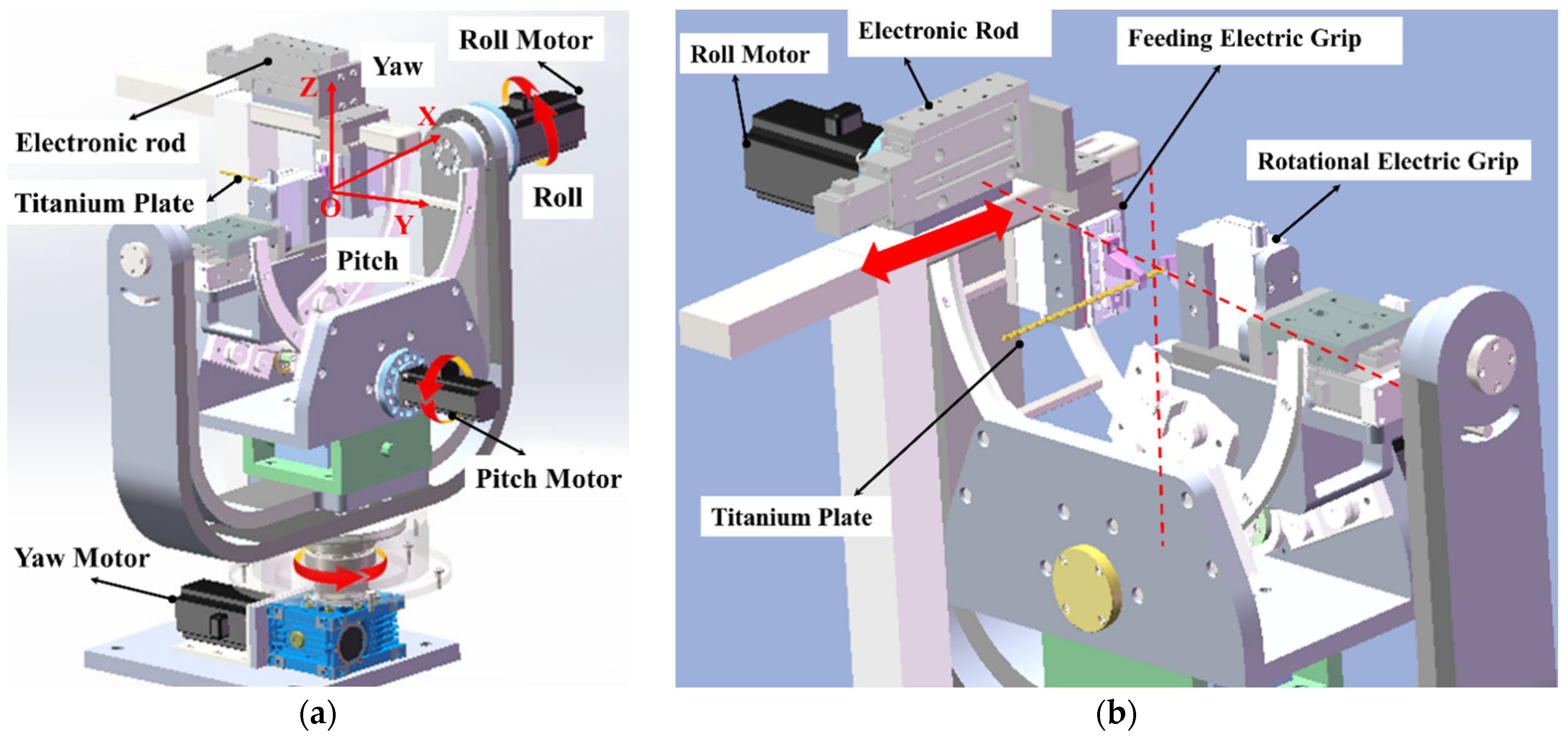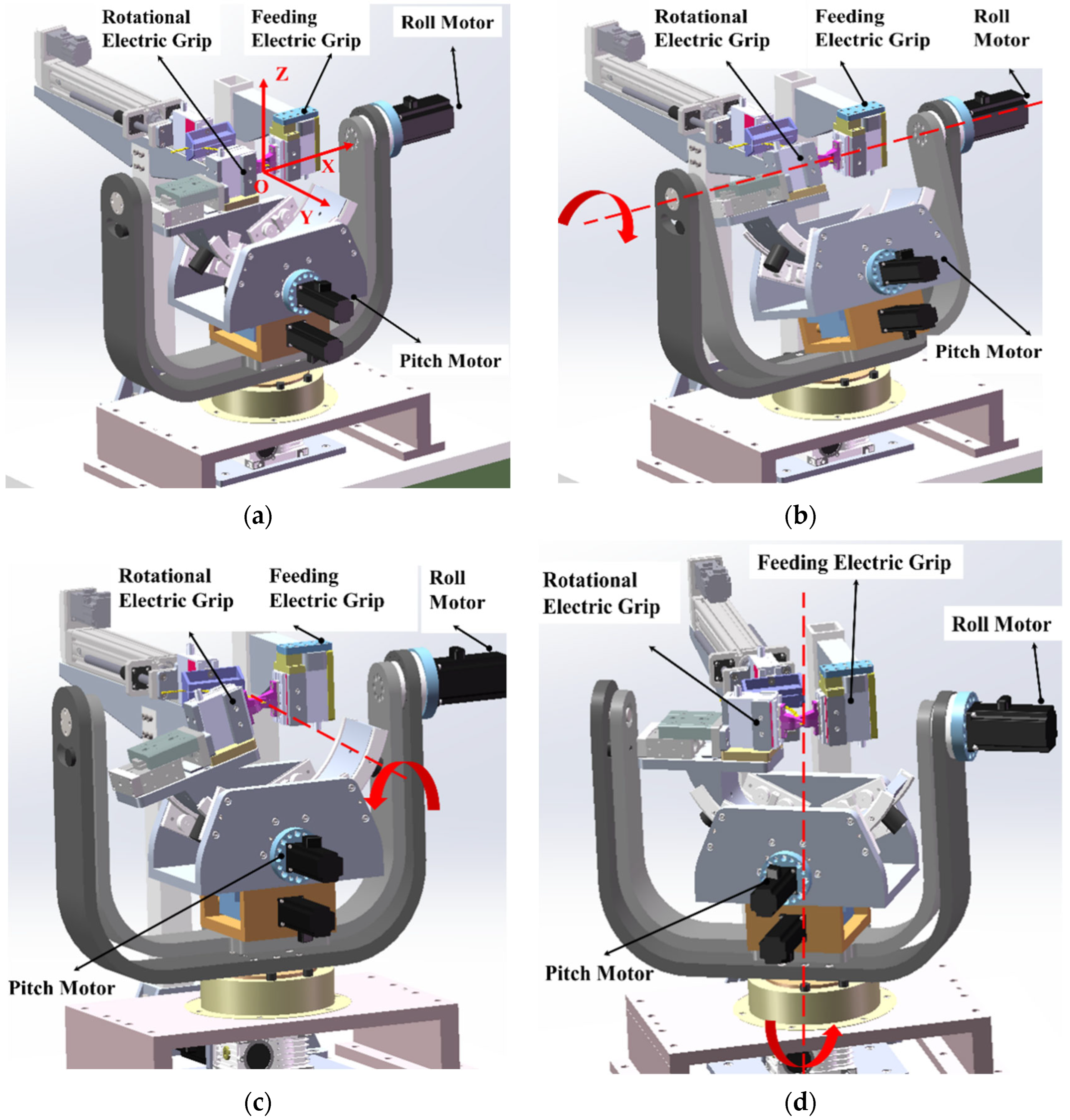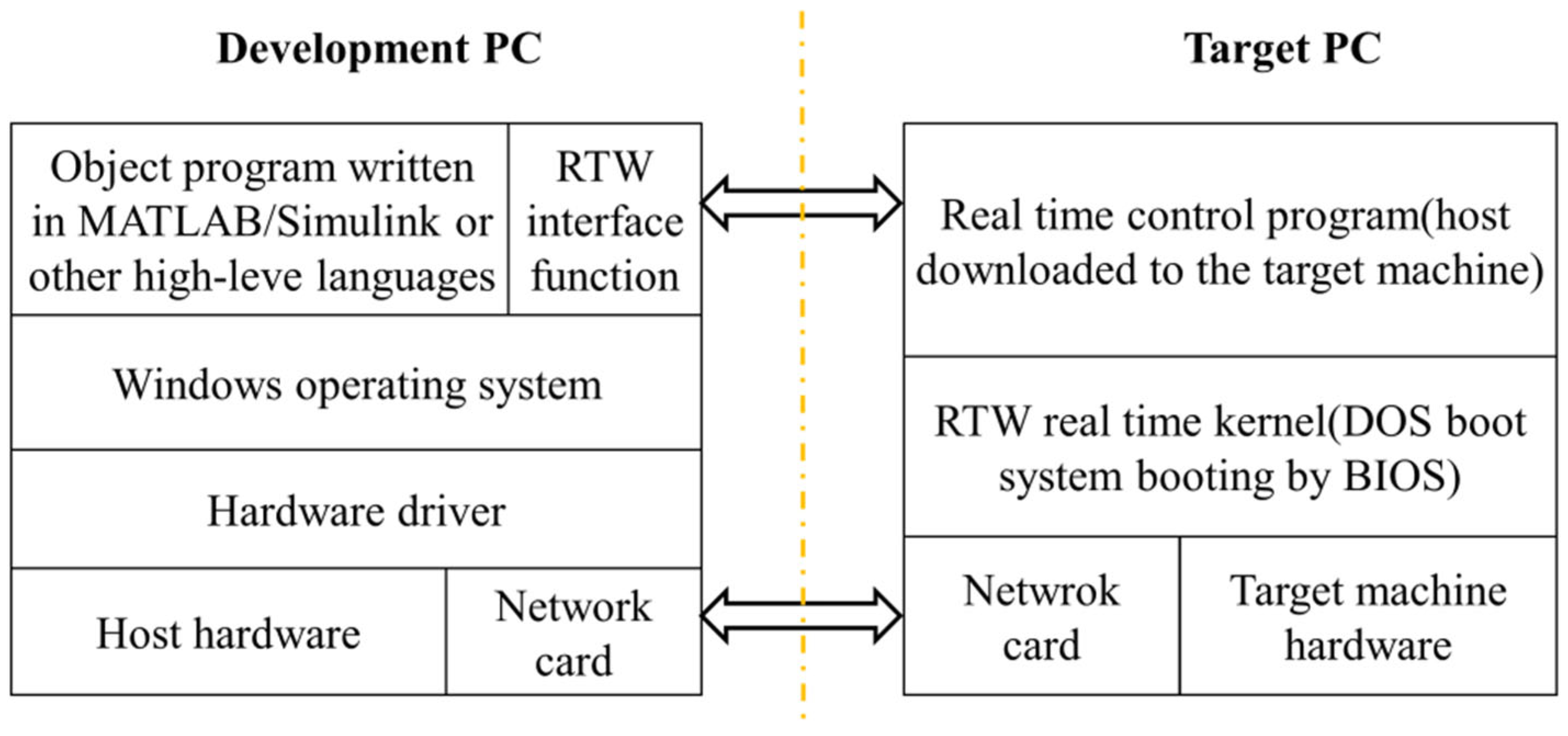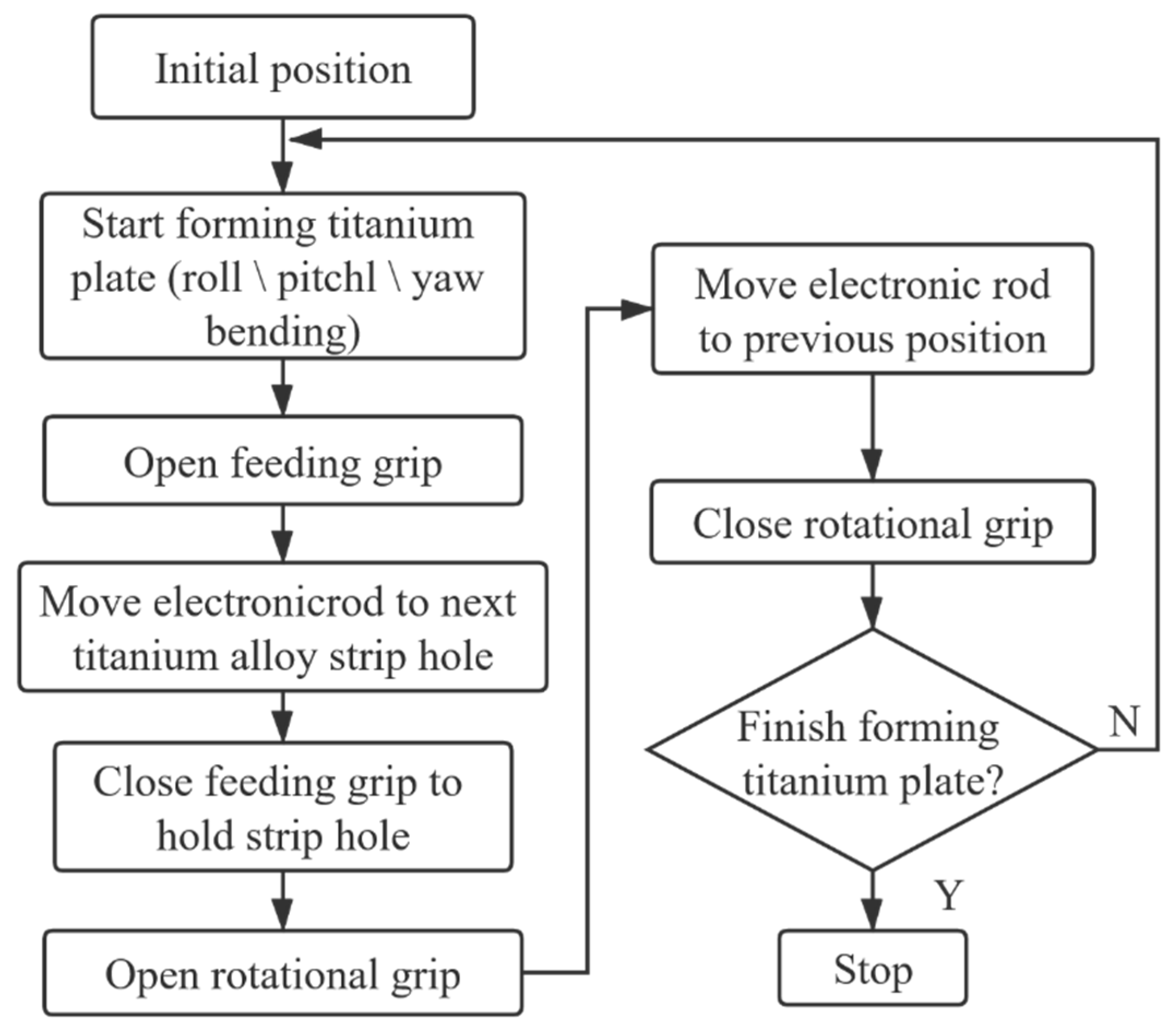Design, Development and Control of a Forming Robot for an Internally Fixed Titanium Alloy Strip
Abstract
:1. Introduction
2. Materials and Methods
2.1. Mechanical System Design
2.2. Electronic System and Controller Design
2.2.1. Electronic Motors/Sensors
2.2.2. Real-Time System
2.2.3. Overall Control System Architecture
3. Results
3.1. Roll Direction Reshape Experiment Result
3.2. Pitch Direction Reshaping Result
3.3. Yaw Direction Reshaping Result
3.4. Overall Reshaped Titanium Alloy Strip Experiment
4. Conclusions
Author Contributions
Funding
Data Availability Statement
Conflicts of Interest
References
- Zhang, C.X.; Yan, X.U.; Bai, X.J. Analysis and countermeasure of the complications after titanium-plate used oral and maxillofacial surgeries. J. Oral Sci. Res. 2015, 31, 814–816. [Google Scholar]
- Defranco, M.J.; Patterson, B.M. The floating shoulder. J. Am. Acad. Orthop. Surg. 2006, 14, 499–509. [Google Scholar] [CrossRef] [PubMed]
- Cole, P.A.; Gauger, E.M.; Schroder, L.K. Management of scapular fractures. JAAOS-J. Am. Acad. Orthop. Surg. 2012, 20, 130–141. [Google Scholar] [CrossRef] [PubMed] [Green Version]
- Hoenecke, H.R., Jr.; Hermida, J.C.; Hernandez, C.F.; D’Lima, D.D. Accuracy of CT-based measurements of glenoid version for total shoulder arthroplasty. J. Shoulder Elb. Surg. 2010, 19, 166–171. [Google Scholar] [CrossRef] [PubMed]
- Jiang, J.G.; Zhang, Y.D.; Wei, C.G.; He, T.H.; Liu, Y. A review on robot in prosthodontics and orthodontics. Adv. Mech. Eng. 2015, 7, 198748. [Google Scholar] [CrossRef] [Green Version]
- Rigelsford, J. Robotic bending of orthodontic archwires. Ind. Robot Int. J. 2004, 31. [Google Scholar] [CrossRef]
- Müller-Hartwich, R.; Jost-Brinkmann, P.G.; Schubert, K. Precision of implementing virtual setups for orthodontic treatment using CAD/CAM-fabricated custom archwires. J. Orofac. Orthop. Fortschr. Der Kieferorthopädie 2016, 77, 1–8. [Google Scholar] [CrossRef] [PubMed]
- Gilbert, A. An in-office wire-bending robot for lingual orthodontics. J. Clin. Orthod. 2011, 45, 230. [Google Scholar] [PubMed]
- Liu, Y. Application of digital manufacturing technology to orthodontics. Chin. J. Stomatol. 2012, 5, 261–266. [Google Scholar]
- Zhang, Y.; Jia, Y. The control of archwire bending robot based on MOTOMAN UP6. In Proceedings of the 2009 2nd International Conference on Biomedical Engineering and Informatics, Tianjin, China, 17–19 October 2009. [Google Scholar]
- DU Hai-Yan, G.U.; Zhang, Y.D.; Liu, Y. Trajectory Planning of Archwire Bending Robot. China Mech. Eng. 2010, 21, 1605. [Google Scholar]
- Jiang, J.G.; Zhang, Y.D.; Zhou, K.; Jiang, J.X. Structure design of archwire bending robot for orthodontic treatment. In Proceedings of the 8th International Forum on Strategic Technology, Ulaanbaatar, Mongolia, 28 June–1 July 2013; pp. 696–699. [Google Scholar]
- Jiang, J.G.; Zhang, Y.D.; Jin, M.L.; Wei, C.G. Bending process analysis and structure design of orthodontic archwire bending robot. Int. J. Smart Home 2013, 7, 345–352. [Google Scholar] [CrossRef]
- Zhang, Y.; Jiang, J. Study on precise acceleration/deceleration planning of archwire bending robot. ICIC Express Lett. 2013, 7, 73–78. [Google Scholar]
- Zhang, Y.D.; Wei, C.G.; Jiang, J.G.; Jiang, J.X.; Liu, Y.; Wang, Y. Motion planning for archwire bending robot in orthodontic treatments. Int. J. Control. Autom. 2014, 7, 287–297. [Google Scholar]
- Zhang, X.; Lu, C.C.; Zhao, Z.F.; Zhong, J. Establishment and research on Springback mathematical model of wire roll bending process. Qinggong Jixie Light Ind. Mach. 2010, 28, 60–65. [Google Scholar]
- Zhang, Y.D.; Jiang, J.X. Analysis and experimental study of bending property of orthodontic archwire. China Mech. Eng. 2011, 22, 1827–1831. [Google Scholar]
- Jiang, J.G.; Ma, X.F.; Zhang, Y.D.; Liu, Y.; Hu, B. Springback mechanism analysis and experimentation of orthodontic archwire bending considering slip warping phenomenon. Int. J. Adv. Robot. Syst. 2018, 15. [Google Scholar] [CrossRef]
- Jiang, J.G.; Ma, X.F.; Zuo, S.H.; Zhang, Y.D.; Liu, Y. Digital expression and interactive adjustment method of personalized orthodontic archwire for robotic bending. J. Adv. Mech. Des. Syst. Manuf. 2019, 13. [Google Scholar] [CrossRef]











| Mechanical Properties of Titanium Alloy | Values |
|---|---|
| Type Composition | TC4 |
| Composition | Ti6Al4V |
| Strip thickness (mm) | 3 |
| Tensile strength δb (MPa) | 895 |
| Yield strength δs (MPa) | 860 |
| Elastic limit δb (MPa) | 967 |
| Geometric Parameter of the Titanium Alloy Strip | Values |
|---|---|
| Length (/mm) | 13 |
| Width (/mm) | 6 |
| Thickness (/mm) | 3 |
| Object | Parameter | Configuration |
|---|---|---|
| Motor for roll and pitch | Type | ST8N40P |
| Nominal Voltage (V) | 24 | |
| Nominal Output (N·m) | 0.32 | |
| Motor for yaw | Type | ST8N60P |
| Nominal Voltage (V) | 24 | |
| Nominal Output (N·m) | 0.64 | |
| Harmonic Gear | Size | 20 |
| Reduction Ratio | 50:1 | |
| Allowable Max Momentary Torque (N·m) | 35 | |
| Size | ST8N40P |
| Specification of the Target PC | Configuration |
|---|---|
| CPU | Intel i5-6500TE |
| CLOCK | 2300 MHz |
| RAM | 4 GB |
| UART | 6-Channel |
| Ethernet | 2 × LAN |
| Memory | CFCard |
Publisher’s Note: MDPI stays neutral with regard to jurisdictional claims in published maps and institutional affiliations. |
© 2022 by the authors. Licensee MDPI, Basel, Switzerland. This article is an open access article distributed under the terms and conditions of the Creative Commons Attribution (CC BY) license (https://creativecommons.org/licenses/by/4.0/).
Share and Cite
Zhang, J.; Shi, B.; Feng, G.; Zuo, G.; Liang, Y. Design, Development and Control of a Forming Robot for an Internally Fixed Titanium Alloy Strip. Machines 2022, 10, 68. https://doi.org/10.3390/machines10020068
Zhang J, Shi B, Feng G, Zuo G, Liang Y. Design, Development and Control of a Forming Robot for an Internally Fixed Titanium Alloy Strip. Machines. 2022; 10(2):68. https://doi.org/10.3390/machines10020068
Chicago/Turabian StyleZhang, Jiaji, Binjun Shi, Guang Feng, Guokun Zuo, and Ye Liang. 2022. "Design, Development and Control of a Forming Robot for an Internally Fixed Titanium Alloy Strip" Machines 10, no. 2: 68. https://doi.org/10.3390/machines10020068






